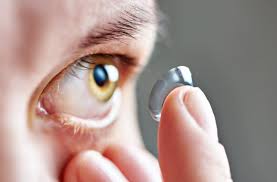Imagine working on your laptop, but now you need to review a contact’s hard copy while also communicating with colleagues sitting at a distance. This can be challenging as your eyes need to focus on multiple things placed at different distances at once. With multifocal lenses, you should be able to do everything easily with clear vision.
What are multifocal lenses?
Multifocal contact lenses refer to multiple prescriptions in one lens. These lenses help correct vision at multiple distances.
Whether you want to read a book, work on a digital screen or look out for someone across the other side of the room, multifocal lenses can make your life easier.
Also known as varifocal or progressive lenses, these lenses are primarily used by people with presbyopia. Presbyopia is an age-related eye condition, which typically occurs with age making it difficult to focus on nearby objects, such as when reading a newspaper. These lenses help you see through different distances and eliminate the need for varifocal glasses.
How do multifocal contact lenses work?
Multifocal lenses work by providing different corrective zones in one lens—near, far, and intermediate. The basic concept is to allow your eyes and brain to process images from these different distance zones simultaneously. The workings will depend on the design of the multifocal lenses you are wearing.
Types of multifocal lens designs
1. Simultaneous
This design includes aspheric and concentric patterns, which help your eyes to look through both the prescriptions at the same time.
Aspheric multifocal lenses work like progressive glasses but without any visible lines on the lens. Concentric pattern on the other hand, contain rings of varying powers that alternate between near and distance vision.
Usually, the centre of both lenses is set for distance and near vision, with a smooth transition between different powers as you move outward.
2. Segmented bifocal design
This design type is also referred to as alternating vision and contains obvious lines on the lens to separate close and near vision. These lenses function similar to bifocal glasses. When you look straight ahead, you see through the top part of the lens, which is made for distance vision. When you lower your eyes, like when reading, you automatically use the lower part of the lens, which is designed for close-up vision. This design makes sure you’re always looking through the right part of the lens for what you’re focusing on.
Benefits of multifocal contact lenses
There are many benefits of multifocal contact lenses:
1. Clear vision at all distances:
With different prescriptions built into one lens, you can easily see objects nearby, far or at an intermediate distance.
2. Convenience:
These lenses eliminate the need for bifocal glasses or different lenses based on your vision needs. You get to enjoy clear vision at all distances with one lens. Multifocals also eliminate the hassle of switching between glasses or lenses with different prescriptions.
3. Improved depth perception:
By correcting vision at multiple distances simultaneously, multifocal lenses can help maintain better depth perception compared to other options, such as monovision lenses (one lens for close-up viewing and one lens for distance vision).
4. Smooth transition:
The gradual transition between different prescription zones provides a more natural visual experience, allowing for smoother focus changes between various distances.
Who should consider multifocal lenses
Multifocal lenses are more beneficial for those suffering from presbyopia, which typically occurs after the age of 40 and makes it difficult to focus on close objects.
For those who have a busy lifestyle, multifocal lenses can be of great help as they eliminate the need to carry an extra pair of prescription glasses or contact lenses. They’re particularly helpful for those who are used to wearing contact lenses but are beginning to have trouble with near vision.
Multifocal contact lenses are also ideal for people who value aesthetics and prefer not to wear glasses. They offer a discreet way to address vision issues without the visible lines of bifocal glasses, maintaining a natural appearance.
Overall, multifocal lenses are a versatile solution for clear vision at all distances, especially if you’re active or experiencing near vision issues. It is important to get your eyes tested first. If you are planning to switch to multifocal lenses, you should consult your optician as they can guide you with the recommended brand and best lens practices.

